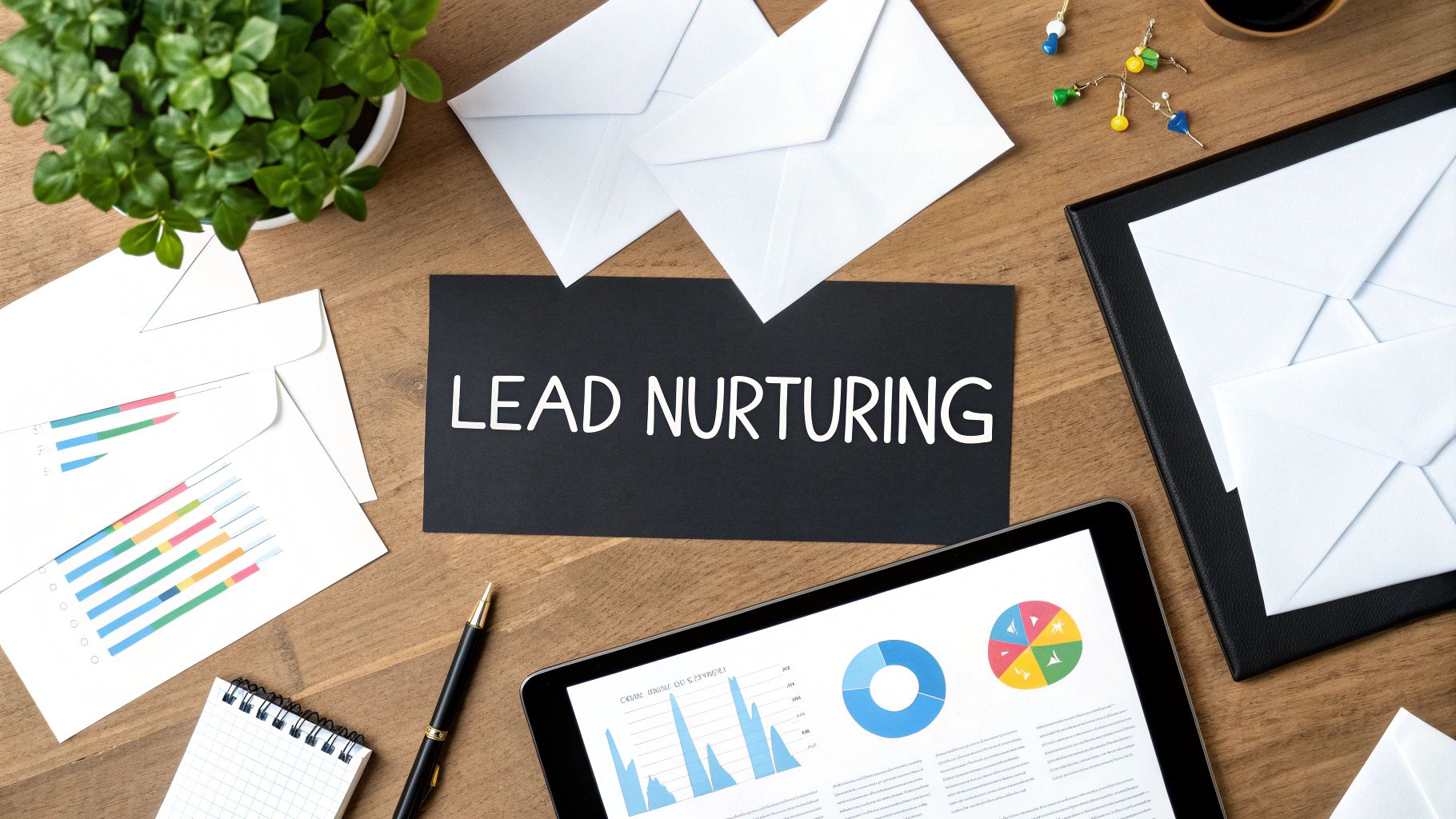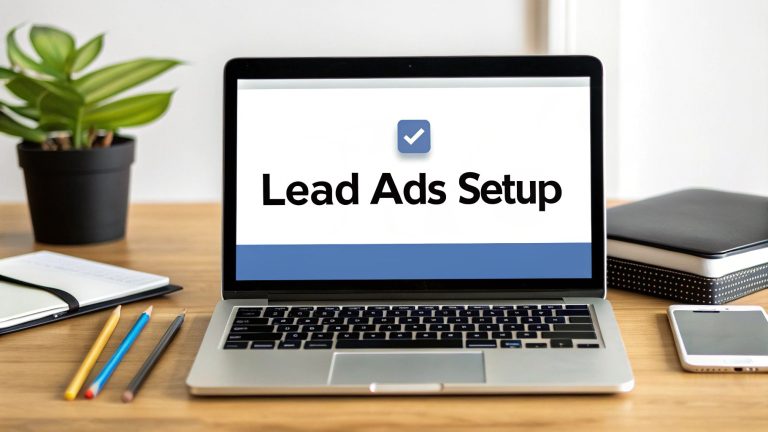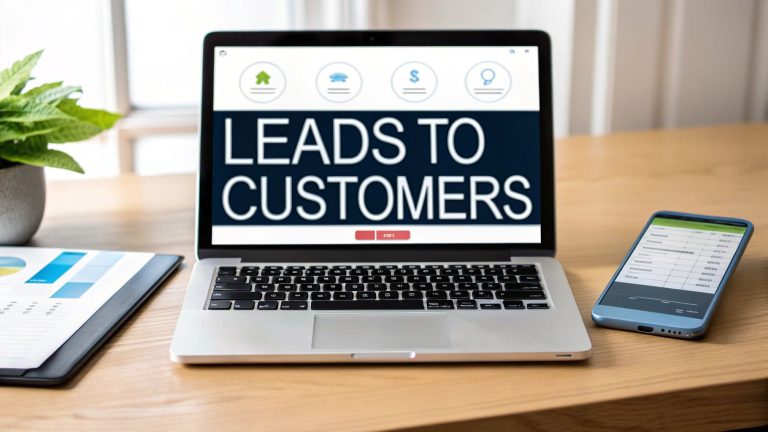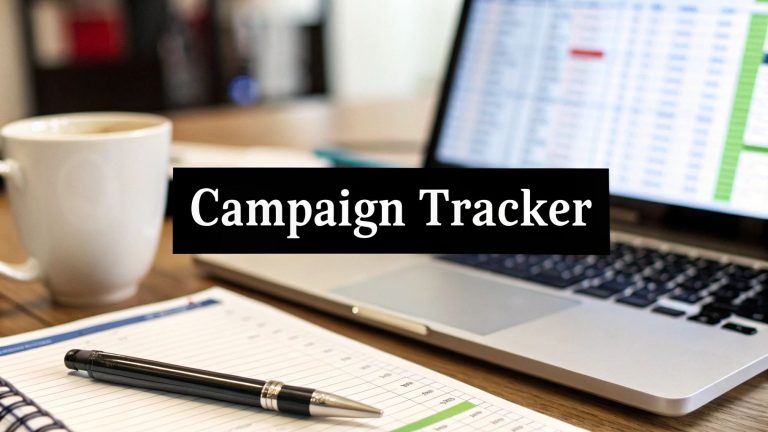8 Lead nurturing email templates You Should Know
Converting a lead into a customer rarely happens overnight. That initial download, sign-up, or inquiry is just the beginning of a conversation. The critical middle part of that journey, where you build trust and demonstrate value, is powered by lead nurturing. Executing this effectively requires a strategic, systematic approach, and that's where proven lead nurturing email templates become an indispensable tool for any marketing or sales professional.
This article moves beyond generic advice and provides a comprehensive toolkit of high-converting templates designed for specific scenarios in the buyer's journey. You won't just get copy-and-paste text; you'll get a strategic breakdown of why each template works. We will dissect the psychology behind each subject line, the structure of the body copy, and the persuasive power of a well-crafted call to action.
Whether you're welcoming a new subscriber, educating them with valuable content, or re-engaging a cold lead, the right email can make all the difference. Our goal is to equip you with actionable, replicable strategies that you can implement immediately. You will learn not just what to say, but how and when to say it to guide your leads from initial interest to final purchase. Get ready to transform your email sequences from simple follow-ups into powerful conversion engines. Each template is a building block for a stronger, more profitable relationship with your audience.
1. Welcome Series Nurturing Template
The welcome series is the cornerstone of effective lead nurturing. It’s not a single email, but a multi-part automated sequence triggered when a new lead subscribes, signs up for a trial, or downloads a resource. Its primary goal is to make a powerful first impression, confirm the value you promised, and guide the new contact toward the next logical step in their journey with your brand. Think of it as a structured onboarding experience that builds immediate trust.
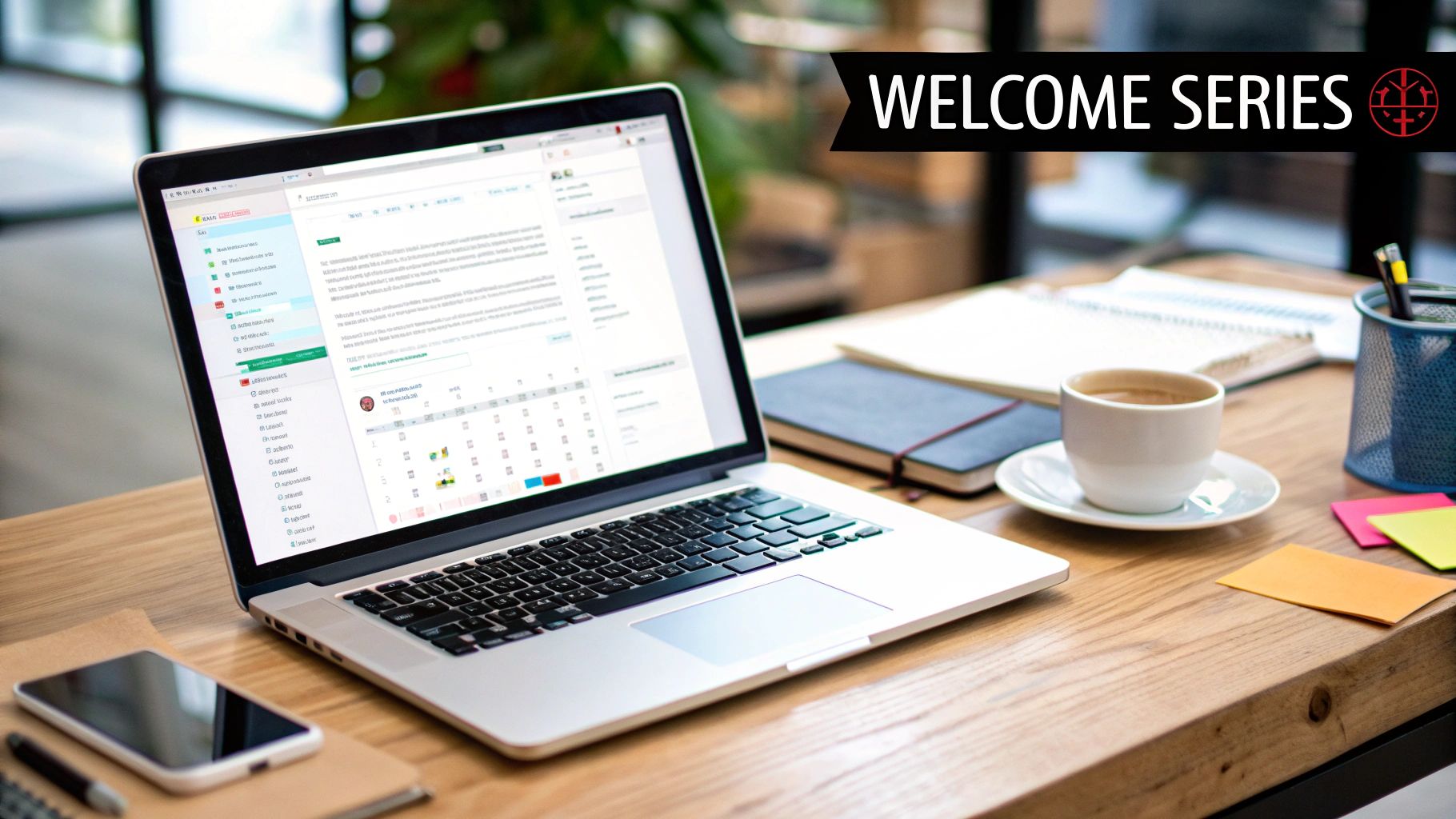
This approach, popularized by inbound marketing leaders like HubSpot, moves beyond a simple "thank you" email. It systematically introduces your brand's personality, highlights key benefits, and educates prospects on how to get the most value from your offerings. For example, Slack's user activation sequence doesn't just welcome you; it teaches you how to use channels, DMs, and integrations over several days, turning passive sign-ups into active users. Similarly, Airbnb's host onboarding series guides new hosts through each step of creating a compelling listing, ensuring they succeed on the platform.
Template and Strategic Breakdown
Here’s a breakdown of a classic three-part welcome series, a foundational structure for many successful lead nurturing email templates.
Email 1: The Instant Value Delivery
- When to Send: Immediately after sign-up.
- Goal: Fulfill the promise and set expectations.
- Subject Line: Your [Resource Name] is here! OR Welcome to [Your Brand]!
- Preview Text: Let's get you started on the right foot.
- Body Copy: Start with a warm welcome and immediately provide the link to the ebook, webinar, or tool they requested. Briefly re-state your brand’s core value proposition and tell them what to expect from you next (e.g., "Keep an eye out for another email in two days with my top tips for…").
- Call to Action (CTA): Download Your Guide Now OR Access Your Account
Strategic Insight: The speed of this first email is critical. An immediate delivery reinforces the lead's decision and capitalizes on their peak interest. Any delay creates doubt and risks your email getting lost in the inbox.
Email 2: The Problem & Solution
- When to Send: 2 days after Email 1.
- Goal: Build rapport by demonstrating you understand their core problem.
- Subject Line: Struggling with [Common Pain Point]? OR A quick tip for [Achieving Goal]
- Preview Text: Here's a proven way to solve it.
- Body Copy: Empathize with a common challenge your target audience faces, one that your product or service helps solve. Share a valuable, actionable tip or a case study. This isn't a hard sell; it's about providing value and building authority.
- Call to Action (CTA): Read the Full Story OR Learn More About [Feature]
Email 3: The Social Proof & Soft Sell
- When to Send: 2-3 days after Email 2.
- Goal: Build trust and introduce your solution more directly.
- Body Copy: Feature a powerful customer testimonial, a 5-star review, or a link to a detailed case study. Show, don't just tell, how you’ve helped others like them. Then, gently pivot to your offer.
- Call to Action (CTA): See How [Customer Name] Succeeded OR Schedule a Demo
2. Educational Content Nurturing Template
Once you've welcomed a new lead, the next crucial phase is to demonstrate your expertise and build trust. The educational content nurturing template excels here. This sequence is designed to provide genuine, actionable value by addressing your lead's most pressing questions, challenges, and pain points. Instead of selling, you’re teaching, positioning your brand as a go-to resource and a trusted advisor in your industry.
This strategy, championed by content marketing pioneers like Joe Pulizzi and widely adopted by B2B SaaS companies, operates on the principle of reciprocity. By generously sharing knowledge, you build a relationship where your solution becomes the natural, logical next step. For example, Moz sends out emails teaching complex SEO techniques, and Buffer provides actionable social media strategy tips. Both build immense credibility, so when they do introduce their product, the audience is already convinced of their expertise.
Template and Strategic Breakdown
This sequence helps guide leads from problem-aware to solution-aware by systematically educating them. It's a core component of many high-performing lead nurturing email templates and marketing automation workflows.
Email 1: The Foundational Problem Solver
- When to Send: 3-4 days after your welcome series ends.
- Goal: Address a broad, high-level problem with a foundational piece of content.
- Subject Line: The ultimate guide to [Topic] OR How to get started with [Core Skill]
- Preview Text: Your step-by-step plan is inside.
- Body Copy: Acknowledge a significant challenge your audience faces. Introduce a comprehensive resource like a pillar blog post, an in-depth guide, or a webinar that provides a complete overview of the solution. Frame it as "the starting point" for success in this area.
- Call to Action (CTA): Read the Ultimate Guide OR Watch the Webinar
Strategic Insight: This first email establishes your authority on a major topic. It shows you understand the bigger picture, not just the small details, building confidence in your ability to guide them.
Email 2: The Specific Tactical Tip
- When to Send: 2-3 days after Email 1.
- Goal: Provide a quick, actionable win to prove your advice works.
- Subject Line: A 5-minute trick to improve [Specific Metric] OR Try this today: [Actionable Tip]
- Preview Text: You can implement this right now.
- Body Copy: Focus on a single, specific pain point and offer one highly practical, easy-to-implement tip. This could be a short "how-to" section, a checklist, or a simple template. The goal is to deliver an immediate "aha!" moment and a feeling of accomplishment.
- Call to Action (CTA): Get the Checklist OR Learn the Technique
Email 3: The Data-Backed Insight & Bridge to Product
- When to Send: 3-4 days after Email 2.
- Goal: Use data to validate the problem and subtly introduce your product as the best tool for the job.
- Body Copy: Share a compelling statistic or finding from a case study (e.g., "Did you know that teams who do X see a Y% increase in Z?"). Explain the insight, then smoothly transition by saying, "We built [Your Product/Feature] to make this easy." For a deeper dive into structuring these sequences, you can learn more about marketing automation workflow examples on leadsavvy.pro.
- Call to Action (CTA): See the Data OR Explore [Your Solution]
3. Social Proof and Testimonial Template
The social proof template is a powerful psychological tool designed to build trust and overcome skepticism. It shifts the focus from what you say about your brand to what other customers have experienced. This approach leverages testimonials, case studies, and user-generated content to demonstrate real-world value, making your claims more credible and relatable. It’s based on the principle that people are more likely to trust their peers than a brand's marketing messages.
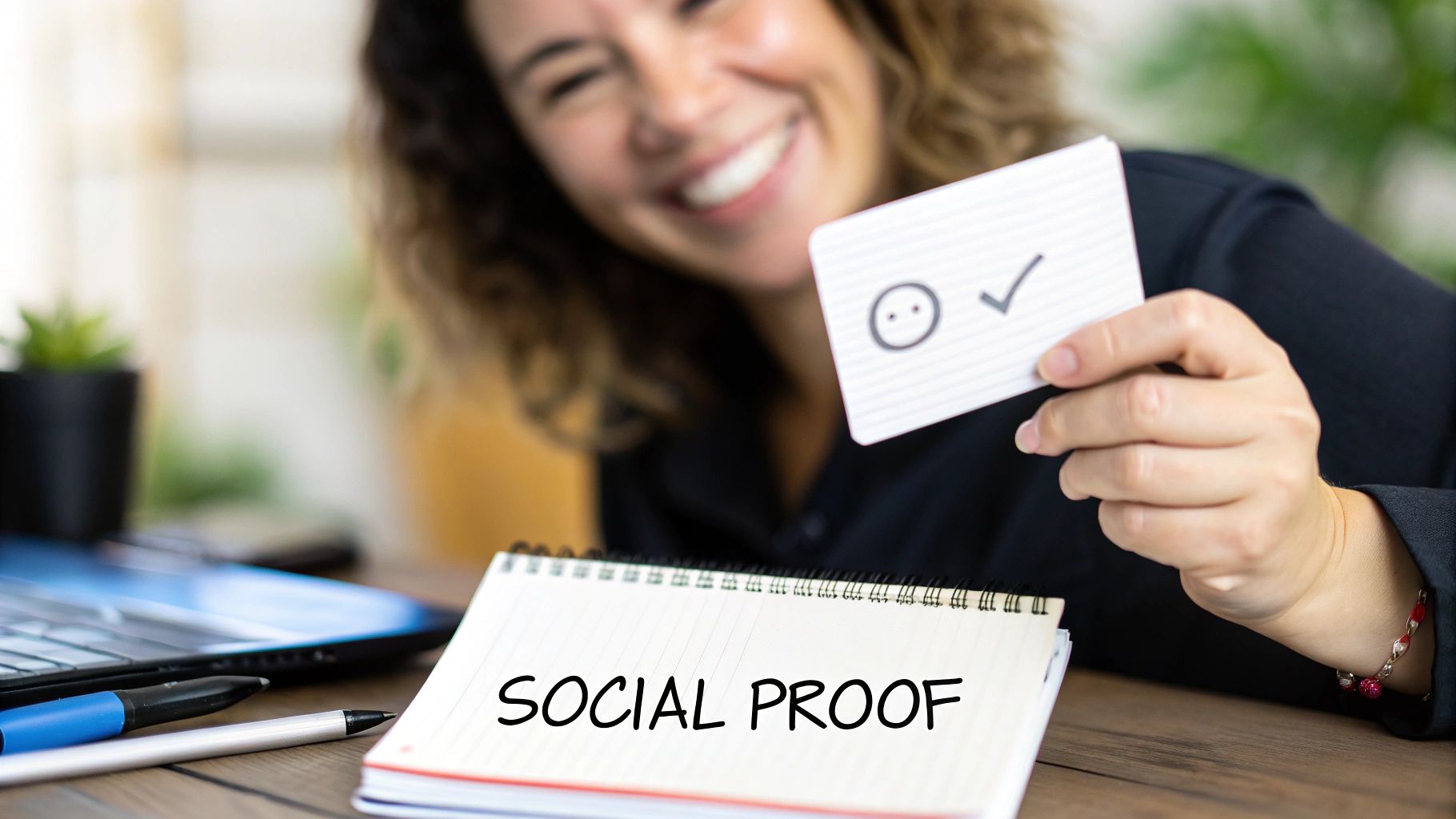
This tactic was popularized by influence experts like Robert Cialdini and has been mastered by companies across industries. E-commerce giant Amazon built its empire on a foundation of customer reviews. In the B2B world, companies like Shopify and Zoom use this method effectively. Shopify highlights merchant success stories with specific revenue figures, while Zoom publishes case studies detailing how organizations improved productivity. This strategy is essential for moving mid-funnel leads who are actively comparing solutions and need validation before committing.
Template and Strategic Breakdown
Here’s a breakdown of a classic social proof email, a critical component in many lead nurturing email templates designed to convert prospects on the fence.
Email 1: The Relatable Success Story
- When to Send: After a lead has engaged with your content but hasn't converted (e.g., visited a pricing page).
- Goal: Show a lead that someone just like them has succeeded with your solution.
- Subject Line: How [Customer Name] achieved [Specific Result] OR See how [Industry] professionals are winning
- Preview Text: Their story might sound familiar to you.
- Body Copy: Open with a relatable problem. Introduce a customer who faced that same challenge. Briefly narrate their journey and highlight the specific, metric-driven outcome they achieved using your product. Use a direct quote from the customer for authenticity. Including a photo or a short video clip of the customer can dramatically increase credibility.
- Call to Action (CTA): Read the Full Case Study OR Watch Their Story
Strategic Insight: The key is relevance. Segment your list and send testimonials from customers in the same industry, company size, or role as the lead. A generic testimonial is good, but a hyper-relevant one is exponentially more powerful.
Email 2: The Objection Crusher
- When to Send: 3-4 days after Email 1.
- Goal: Proactively address a common sales objection using social proof.
- Subject Line: "I thought it was too expensive, until…" OR Was [Common Objection] holding you back?
- Preview Text: Here's what [Customer Name] had to say about it.
- Body Copy: Directly address a known friction point, such as price, complexity, or implementation time. Then, feature a testimonial from a customer who had the exact same concern but found the value outweighed the cost or the process was easier than expected. This validates the lead's concerns while simultaneously resolving them through a trusted third-party voice.
- Call to Action (CTA): See Why It's Worth It OR Learn About Our Onboarding
Email 3: The "Wisdom of the Crowd"
- When to Send: 3-4 days after Email 2.
- Goal: Create a sense of momentum and broad acceptance.
- Body Copy: Instead of one deep-dive story, showcase a collection of short, punchy reviews or ratings from a third-party site like G2, Capterra, or Trustpilot. Use phrases like "Join 10,000+ happy customers" or "Rated 4.9/5 by marketing managers." This demonstrates widespread satisfaction and reduces the perceived risk of choosing your solution.
- Call to Action (CTA): See All Our Reviews OR Ready to Join Them? Schedule a Call
4. Problem-Solution Narrative Template
Humans are wired for stories. The problem-solution narrative template taps into this fundamental cognitive bias by framing your product or service as the hero in your lead’s story. This approach moves beyond listing features and benefits; it creates an emotional and logical journey that starts with a relatable problem, explores the pain it causes, and culminates with your offering as the ideal resolution. It’s a powerful method for building deep connections and making your solution memorable.
This storytelling technique has been a staple for direct response marketers and disruptive brands for decades. Warby Parker used it to tell the story of overpriced, inaccessible eyewear, positioning themselves as the fair-priced, convenient alternative. Similarly, Basecamp’s entire marketing ethos is built on the narrative of escaping project management chaos and finding clarity. This method transforms your emails from a sales pitch into a compelling story where the lead is the protagonist.
This infographic illustrates the simple yet powerful three-act structure that underpins this narrative approach.
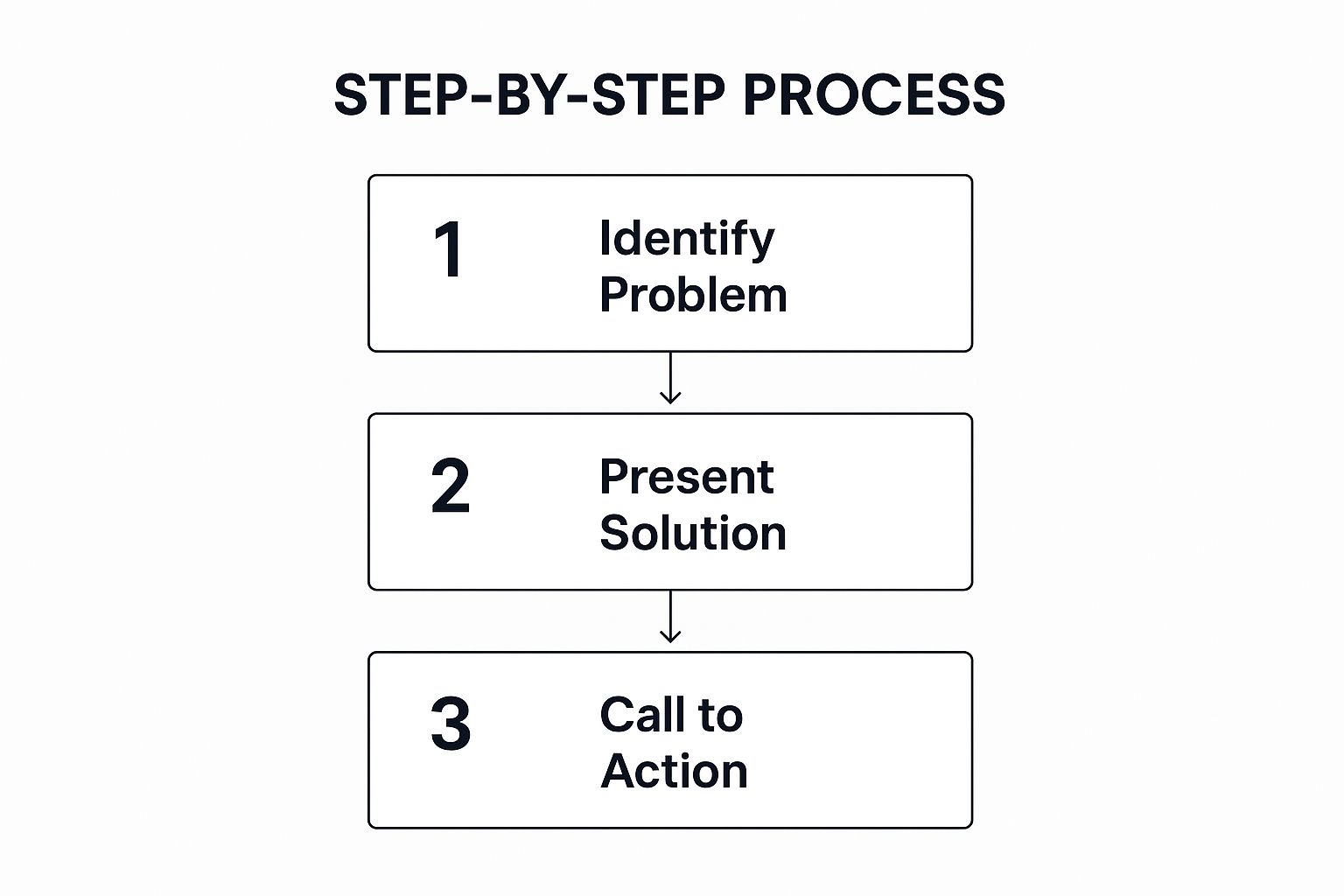
The visualization shows a clear progression from agitating a known problem to presenting a clear path forward with your solution, guiding the lead toward a specific action.
Template and Strategic Breakdown
Here is a breakdown of a two-part problem-solution narrative sequence, a foundational structure for many compelling lead nurturing email templates.
Email 1: The Relatable Problem
- When to Send: After an initial welcome or value-delivery email.
- Goal: Build empathy and confirm you understand their world.
- Subject Line: The real reason [Common Task] is so frustrating OR Is [Common Problem] slowing you down?
- Preview Text: We've been there, and we've seen this before.
- Body Copy: Start with a vivid, detailed description of a common pain point. Use the exact language your customers use. The goal is to make them nod and think, "Yes, they get it." Don't introduce your product yet; focus entirely on the problem and its consequences to build narrative tension.
- Call to Action (CTA): Learn the 3 signs of [Problem] OR Read more about this challenge
Strategic Insight: The power of this email lies in its specificity. Vague problems get vague responses. By detailing a specific, relatable struggle (e.g., "spending hours manually cross-referencing spreadsheets" instead of "inefficient workflows"), you earn the credibility needed to present a solution.
Email 2: The Hero's Arrival (Your Solution)
- When to Send: 2-3 days after Email 1.
- Goal: Position your product as the logical and emotional solution to the problem you just detailed.
- Subject Line: A simpler way to [Achieve Goal] OR What if [Common Problem] was a thing of the past?
- Preview Text: Here’s how [Your Brand] helps.
- Body Copy: Directly reference the problem from the previous email. Then, introduce your product or service as the specific antidote. Explain how it solves the problem, focusing on the transformation from a state of frustration to one of relief or success. Use a mini-case study or a customer quote to make the resolution tangible.
- Call to Action (CTA): See How It Works OR Start Your Free Trial
5. Product Feature Education Template
Once a lead understands the general problem you solve, the next step is to show them how you solve it with tangible features. The product feature education template is a systematic series of emails designed to highlight specific capabilities, use cases, and benefits of your solution. Instead of overwhelming a lead with everything at once, this sequence unpacks your product’s value piece by piece, making it more digestible and relevant.
This approach is crucial for SaaS companies, technology platforms, or any business with a multifaceted product. The goal is to connect a lead’s specific pain points directly to a feature that offers a clear solution. For example, Canva doesn't just say "we make design easy"; it sends emails demonstrating how to use its Background Remover, Magic Resize tool, or specific video templates. Similarly, Asana breaks down project management into digestible emails about timelines, boards, and reporting features, ensuring users grasp the full scope of its power.
Template and Strategic Breakdown
This multi-part sequence can be adapted based on your product’s complexity. The key is to focus each email on a single, high-impact feature or a cluster of related features that solve a specific problem.
Email 1: The High-Impact Feature Spotlight
- When to Send: After a lead has shown initial engagement (e.g., visited the pricing page, attended a webinar).
- Goal: Showcase your most popular or "aha!" moment feature.
- Subject Line: Did you know you could do this with [Your Brand]? OR Simplify [Specific Task] in 2 minutes
- Preview Text: Here’s a feature our customers love.
- Body Copy: Start by re-stating a common goal or frustration. Immediately introduce the feature as the solution. Use a GIF, a short video, or a clear screenshot to demonstrate the feature in action. Briefly explain the benefit, such as "Save hours on manual data entry" or "Create professional designs without a designer."
- Call to Action (CTA): Try It Now OR Watch a Quick Demo
Strategic Insight: Lead with the benefit, not the feature name. Users care about what the feature does for them, not what it's called. Visuals are non-negotiable here; showing is far more powerful than telling when it comes to software.
Email 2: The Use-Case Deep Dive
- When to Send: 3-4 days after Email 1.
- Goal: Connect a different feature to a specific role-based or industry-specific problem.
- Subject Line: A tip for [Target Role, e.g., Marketing Managers] using [Your Brand]
- Preview Text: A smarter way to manage your [Task].
- Body Copy: This email should be more targeted. Address a specific use case relevant to a segment of your audience. For example, "As a sales leader, tracking team performance is critical. Our reporting dashboard gives you a real-time view…" Link to a blog post or help-center article that provides a more detailed tutorial.
- Call to Action (CTA): Explore the [Feature Name] Dashboard OR See How It Works
Email 3: The Integration & Power-User Angle
- When to Send: 3-4 days after Email 2.
- Goal: Demonstrate how your product fits into their existing workflow and reveal advanced capabilities.
- Body Copy: Showcase how your product integrates with other tools they already use (e.g., Slack, Google Drive, Salesforce). This reduces the perceived friction of adoption. You can also highlight a "power-user" tip or an underutilized feature that unlocks significant efficiency.
- Call to Action (CTA): Connect Your Apps OR Become a [Your Brand] Pro
6. Event-Triggered Behavioral Template
Event-triggered behavioral templates represent the peak of responsive and personalized lead nurturing. Unlike a pre-set series, these emails are deployed in real-time based on a lead's specific actions or inactions. Whether a prospect visits a pricing page, watches a product demo video, or clicks a specific link in a previous email, a behavioral trigger can send a hyper-relevant message at the moment of highest intent. This dynamic approach ensures your communication is always contextual and timely.
This powerful strategy has been mastered by e-commerce giants and SaaS leaders. Amazon's famous "Customers who viewed this item also viewed…" emails are a prime example, triggered by browsing history to encourage further exploration. Similarly, marketing automation platforms like Marketo and Klaviyo enable businesses to build complex workflows, sending targeted follow-ups when a lead downloads a second resource on the same topic, signaling a deepening interest. It’s the closest thing to having a sales rep watch over a prospect's shoulder and offer the perfect piece of information at the right time.
Template and Strategic Breakdown
Behavioral triggers are incredibly versatile. Here’s a strategic breakdown of how to structure these lead nurturing email templates for two common scenarios: a high-intent website action and a disengagement signal.
Trigger 1: The High-Intent Action (e.g., Visited Pricing Page)
- When to Send: 1-2 hours after the lead visits a key page (like pricing or features) but doesn't convert.
- Goal: Address potential questions or friction and provide a clear path to conversion.
- Subject Line: Questions about our [Product/Pricing]? OR A quick resource for you
- Preview Text: We're here to help you make the right choice.
- Body Copy: Acknowledge their interest in a helpful, non-creepy way. For example, "Noticed you were checking out our pricing plans. We know it can be a lot to take in." Then, offer direct value related to that page. This could be a link to a detailed feature comparison guide, an invitation to a live Q&A session, or a link to a case study from a similar company.
- Call to Action (CTA): View Comparison Chart OR Chat with an Expert
Strategic Insight: The delay is crucial. Sending an email the second they hit the page feels invasive. A short delay makes it feel like a thoughtful follow-up rather than automated surveillance. This kind of automated lead nurturing is key to converting prospects who are on the fence. For a deeper dive, you can learn more about crafting these automated sequences on leadsavvy.pro.
Trigger 2: The Re-Engagement Nudge (e.g., Inactive for 30 Days)
- When to Send: After a defined period of inactivity (e.g., no email opens, clicks, or site visits for 30 days).
- Goal: Re-capture attention with a high-value offer or a simple check-in.
- Subject Line: Still interested in [Achieving Goal]? OR Is it something we said?
- Preview Text: Let's get you back on track with this…
- Body Copy: Keep it light and focused on value. Remind them of the value proposition they were initially interested in. Offer your most popular resource, announce a significant product update, or provide an exclusive piece of content. The goal isn't to sell hard, but to remind them why they subscribed in the first place.
- Call to Action (CTA): Get Your Free Template OR See What's New
7. Industry Insights and Trends Template
The Industry Insights and Trends template shifts the focus from your product to the broader industry landscape. Instead of talking about features, you share valuable market analysis, expert commentary, and future predictions. This approach establishes your brand not just as a solution provider, but as a genuine thought leader and trusted advisor. Its goal is to build deep-seated authority and keep your brand top-of-mind by delivering high-value intelligence that helps your leads do their jobs better.
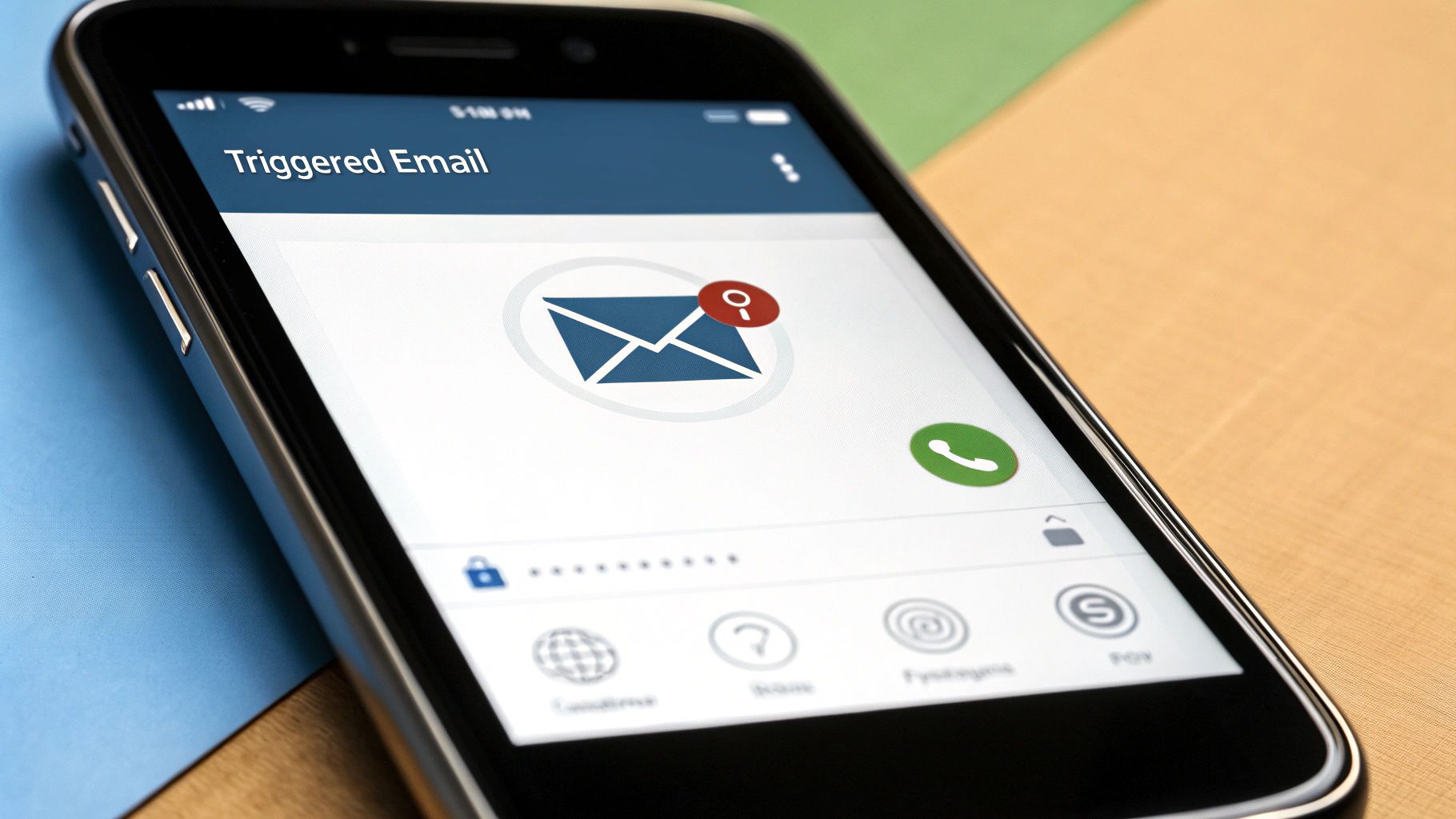
This strategy was perfected by management consulting firms like McKinsey and research organizations like Gartner. They understood that providing leaders with exclusive, data-backed insights was a powerful way to build relationships long before a sales conversation ever began. By offering unique perspectives rather than rehashing common knowledge, these emails become a must-read for anyone serious about their industry, creating a loyal and engaged audience of potential high-value customers.
Template and Strategic Breakdown
Here’s how to structure an effective industry insights email, a key component in any advanced set of lead nurturing email templates.
The Core Structure: Data, Insight, Implication
- When to Send: On a consistent schedule (e.g., monthly or quarterly) to create anticipation.
- Goal: Reinforce your brand's expertise and provide actionable intelligence.
- Subject Line: [Report] The State of [Industry] in [Year] OR 3 Trends Shaping [Your Audience's Field]
- Preview Text: What our latest data means for your strategy.
- Body Copy: Start with a bold, data-backed statement or a key finding. Present the core insight clearly and concisely, using a chart or a key statistic for visual impact. Most importantly, explain the implication of this trend for your reader's business. Connect the dots for them: "This trend means you need to consider…"
- Call to Action (CTA): Read the Full Report OR Get the Analysis
Strategic Insight: The power of this template lies in its "so what" factor. Don't just present data; interpret it. Your unique perspective and actionable recommendations are what differentiate your email from a generic news update. This builds true authority and trust.
Key Elements for Maximum Impact
- Credible Data: Always back your insights with verifiable research, whether it's your own proprietary data or a credible third-party source. Citing sources builds immense trust.
- Actionable Takeaways: Frame the information around what the lead should do next. For instance, if you highlight a trend in AI adoption, provide a tip on a small, low-risk way they can start experimenting with it. This bridges the gap between information and action.
- Forward-Looking Perspective: Offer predictions or expert commentary on what's coming next. This positions you as a forward-thinking partner who can help leads navigate the future, not just react to the present. By tracking the results of these thought leadership emails, you can master your lead generation performance metrics and understand what content truly resonates with your audience.
8. Re-engagement and Win-Back Template
A re-engagement or win-back campaign is a crucial, often-overlooked strategy for reviving your lead database. This automated sequence targets contacts who have gone "cold" – they haven't opened emails, clicked links, or visited your site in a significant period (e.g., 90-180 days). Its goal isn't just to get a click, but to remind them of the value you offer, showcase what’s new, and give them a compelling reason to become active again. It's a proactive measure to clean your list and maximize the value of every lead you've acquired.
This strategy has been perfected by subscription-based businesses and major e-commerce brands who understand that reactivating an existing lead is far more cost-effective than acquiring a new one. For instance, Spotify’s iconic "We miss you" emails use personalized playlists to entice inactive users back. Similarly, Grammarly sends writing challenges to lapsed users, reigniting their interest by providing immediate, tangible value. These campaigns acknowledge the silence and bridge the gap with a strong value proposition.
Template and Strategic Breakdown
Here’s a breakdown of a classic two-part re-engagement sequence, a foundational structure for many successful lead nurturing email templates aimed at winning back cold leads.
Email 1: The Gentle Nudge & Value Reminder
- When to Send: After 90 days of inactivity (or your defined threshold).
- Goal: Re-establish connection and gauge interest without being pushy.
- Subject Line: Is [Your Brand] still a priority for you? OR Still interested in [Achieving Goal]?
- Preview Text: We've missed you. Here's what's new.
- Body Copy: Start by acknowledging the time gap in a friendly, non-accusatory way. Briefly remind them why they signed up in the first place, tying it back to a core pain point. Showcase one or two major updates or pieces of high-value content you've released since they last engaged.
- Call to Action (CTA): Check Out What's New OR See Our Latest [Resource Type]
Strategic Insight: The tone here is critical. Avoid making the lead feel guilty. Instead, frame it as a helpful check-in. The goal is a simple response, even just an open, to signal they are still listening. This first step helps you segment truly dead leads from those who are merely dormant.
Email 2: The Final Offer & Preference Update
- When to Send: 7-10 days after Email 1 if there's no engagement.
- Goal: Make a last-ditch effort with a strong incentive and provide an easy way to manage preferences.
- Subject Line: We’re saying goodbye… unless you say otherwise. OR A special offer to welcome you back.
- Preview Text: Don't miss out on this before you go.
- Body Copy: Be direct and transparent. State that you value a clean and engaged email list and plan to remove them to respect their inbox. Before you do, present a compelling reason to stay, like a special discount, extended trial, or exclusive access. Crucially, offer an alternative to a full unsubscribe.
- Call to Action (CTA): Keep Me on The List OR Update My Email Preferences
Lead Nurturing Email Templates Comparison
| Template | Implementation Complexity 🔄 | Resource Requirements 💡 | Expected Outcomes 📊 | Ideal Use Cases 💡 | Key Advantages ⭐ |
|---|---|---|---|---|---|
| Welcome Series Nurturing Template | Medium – multi-email sequence, automation setup required | Moderate – planning, segmentation, testing | High engagement and measurable conversions | Onboarding new leads post opt-in | Scalable automation, high engagement |
| Educational Content Nurturing Template | High – substantial content creation effort | High – research, writing, resources | Builds authority, high-quality engagement | Lead nurturing with educational focus | Builds trust, generates shareable content |
| Social Proof and Testimonial Template | Medium to High – coordination with customers and content curation | Moderate to High – collecting and producing testimonials | Increases conversions significantly | Overcoming objections, building credibility | Highly persuasive, emotional connection |
| Problem-Solution Narrative Template | High – requires strong copywriting and storytelling | Moderate – creative development, testing | Strong emotional connection and engagement | Story-driven sales progression | Engaging and memorable narrative flow |
| Product Feature Education Template | Medium – detailed feature content creation | Moderate to High – updates, multimedia | Improved product understanding | Educating on product capabilities | Reduces confusion, addresses use cases |
| Event-Triggered Behavioral Template | High – complex automation and real-time triggers | High – marketing automation tools, data tracking | Highly relevant, improved conversions | Behavior-based personalized messaging | Timely, automated, detailed insights |
| Industry Insights and Trends Template | High – requires deep expertise and research | High – research, data analysis | Long-term brand authority and thought leadership | Thought leadership and market positioning | Establishes authority, attracts leads |
| Re-engagement and Win-Back Template | Medium – sequence design with triggers | Moderate – content creation, timing management | Recovers cold leads, improves list health | Re-engaging inactive or disengaged leads | Cost-effective lead recovery |
Final Thoughts
We've explored a comprehensive arsenal of lead nurturing email templates, moving far beyond simple, generic messages. The goal has been to equip you not just with copy-and-paste text, but with the strategic framework necessary to transform a passive lead into an enthusiastic customer and, eventually, a loyal brand advocate. The journey from a prospect's initial curiosity to their final purchase decision is a delicate one, paved with intentional, value-driven communication.
As we've seen through the Welcome Series, the Educational Content sequence, and the powerful Problem-Solution Narrative, the most effective nurturing isn't about hard selling. It's about building a relationship founded on trust and expertise. It's about understanding your lead's pain points, anticipating their questions, and delivering the right information at precisely the right moment.
From Templates to Triumphs: Core Strategic Takeaways
The true power of these lead nurturing email templates isn't in their exact wording, but in the psychological principles and strategic thinking behind them. To truly master lead nurturing, internalize these core concepts we've discussed:
- Segmentation is Non-Negotiable: The Event-Triggered Behavioral Template is a prime example of this. You cannot send the same message to a lead who has visited your pricing page three times and one who has only downloaded a top-of-funnel ebook. Segmenting your audience based on behavior, demographics, and engagement level allows you to deliver hyper-relevant content that resonates deeply.
- Value Precedes the Ask: Before you ask for the sale, you must provide undeniable value. This was the central theme of the Educational Content, Industry Insights, and Product Feature templates. By educating your leads and helping them solve smaller problems, you earn the right to present your product as the ultimate solution.
- Trust is a Currency: The Social Proof and Testimonial Template directly addresses this. People buy from businesses they trust. Weaving customer stories, case studies, and authentic reviews into your nurture sequence provides the validation many leads need to overcome their final purchasing hesitations. It’s the digital equivalent of a trusted friend’s recommendation.
- Automation is Your Ally: The Re-engagement and Win-Back Template highlights the power of automation to maintain relationships even with disengaged leads. A well-designed automated workflow ensures no lead is forgotten and that your communication remains consistent, timely, and scalable without manual intervention.
Your Actionable Path Forward
Moving from theory to practice is the most critical step. Don't let this collection of lead nurturing email templates sit idle. Here is your immediate action plan to implement what you've learned:
- Audit Your Current Funnel: Start by mapping out your existing lead-to-customer journey. Where are the gaps? Are you sending a generic welcome email and then jumping straight to a sales pitch? Identify the biggest opportunity for a new nurture sequence.
- Choose One Template to Implement: Don’t try to build all eight sequences at once. Pick the one that addresses your most significant gap. Is it welcoming new leads effectively? Start with the Welcome Series. Are you losing leads after 30 days? Implement the Re-engagement Template.
- Customize and Personalize: Take the chosen template and adapt it to your brand voice, your specific product, and your unique customer persona. Use personalization tokens for names and companies, but also tailor the content to the lead source or initial interest.
- Set Clear Goals and Measure: Define what success looks like for your new sequence. Is it a higher click-through rate, more demo bookings, or a direct increase in sales? Track your key metrics, test your subject lines, and continuously optimize for better performance.
Ultimately, successful lead nurturing is an art and a science. It's the art of human connection combined with the science of data-driven marketing automation. By implementing these strategically designed lead nurturing email templates, you are not just sending emails; you are building a scalable, predictable engine for growth that will serve your business for years to come.
Ready to put these strategies into action with powerful, intuitive automation? LeadSavvy Pro provides the tools you need to build, segment, and automate every template discussed in this guide. Stop letting valuable leads slip through the cracks and start building your automated growth engine today with LeadSavvy Pro.

